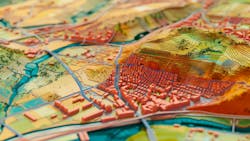How are AI and GIS revolutionizing stormwater management?
Artificial intelligence (AI) and geographic information systems (GIS) are rapidly changing the workflows of stormwater professionals. Their capabilities range from enhancing sediment control methods to detecting defects in infrastructure. This utility is unprecedented, making the industry’s future equipped to handle the complexities of future water management.
High-resolution mapping and modeling
GIS is ideal for mapping vulnerable areas like watersheds. The surveying equipment comes with lidar, which measures elevation data, soil health and coverage. Once the technology finishes constructing visuals on the area, AI algorithms can use the data to create hydrologic simulations.
Experts can see runoff, storm flows and wildlife movement before severe weather hits the region. With these insights, they can optimize stormwater infiltration system placement. Identifying groundwater potential zones has also been effective in reducing water scarcity in arid climates.
Real-time monitoring with adaptive controls
Sensor-based technologies like the Internet of Things (IoT) are perfect data collectors for AI datasets. Workers can place them anywhere, including in the soil to detect moisture changes or on shores to measure rainfall or rising levels. Integrate this with a GIS platform, and professionals can adapt stormwater infrastructure based on incoming trends. For example, they could alter the flows of detention ponds based on more accurate data instead of guesswork.
Predictive stormwater infiltration system maintenance
Stormwater infrastructure has tons of moving parts, many in hard-to-reach places. Sensors prevent professionals from using invasive methods, while giving them constant visibility over when critical systems need attention. It could predict when soil weights put pressure on pipes or notice when biofilm forms on controllers, transforming workflows to be more proactive instead of reactive.
An AI platform can use this information to create inspection and maintenance plans. Staff can use advanced cameras with LED lighting and internet connectivity to send photos to software for instant analysis. They are useful for seeing in harsh and dark environments like sewage systems. Algorithmic visualizations or other tools like digital twins paired with GIS information can reveal the most present defects in infiltration basins or the frequency of sediment-related clogs.
Optimized placement of sediment control BMPs
GIS mapping and analytics can tell stormwater experts about the most vulnerable regions they are surveying. With the help of AI, it could identify high erosion potential because of sloping information or land cover. Then, the algorithm can recommend the best management practices for remedying concerns, such as installing sediment traps or fences.
Improved sediment basin design
Every sediment basin is slightly different from the next, varying because of particle sizes, flow-rate potential and numerous other factors. GIS can take geographical and land data and create a digital representation. Employees can manipulate it to figure out the best design before building. Oftentimes, sediment basin design creates runoff and pollution because of poor planning, but AI and GIS work together to mitigate some of these negative consequences and encourage better decision-making.
Additionally, teams can implement AI-enhanced site erosion control during and after construction. While a job is in progress, sensors can relay when turbidity exceeds expectations or when rainfall could jeopardize a project. Then, they can take action by employing geoengineering practices to reinforce the soil.
Enhanced public education and outreach
While GIS and AI give industry stakeholders numerous tools to streamline their jobs, they can also help the public understand more about these critical systems. Sector leaders can use the interactive maps in GIS programs to educate students at schools or install AI chatbots to answer questions on city websites.
Climate change adaptation planning
The climate crisis greatly affects stormwater management because of changing precipitation and natural disaster frequency. Infrastructure is also antiquated and vulnerable, making adaptation planning an essential priority for resilient and agile firms.
GIS technology can view a region and compare it to previous years. It will present companies with geological and hydraulic shifts, giving people an idea of how to prepare for worsening conditions. This advancement could also inspire increased capacities of infiltration systems or the adoption of new sediment control methods.
Corporations adopting more sustainable, leaner business practices may also use AI to make greener infrastructure site selections. AI can assess vast quantities of data about each choice — including its closeness to waterways and soil permeability — to help people decide on the most intuitive and eco-friendly location.
Predictive modeling of algal blooms in stormwater ponds
Harmful algal blooms destroy aquatic ecosystems, reproducing so rapidly that they become uncontrollable before experts notice. AI-powered remote monitors over vulnerable water bodies can observe changes in essential quality data, like pH and nutrient densities. Any shifts indicating the presence of algal blooms can alert workers to take swift action. Doing this preserves water quality for nearby communities and saves other species from having limited access to what they need to survive.
The technology is versatile and could even detect novel pollutant threats like microplastics. These are difficult to spot because of their size, yet they take 20 years to decompose. Stormwater experts must collaborate with treatment professionals to ensure new and emerging contaminants remain controllable, and aerial sensor-based devices are ideal for keeping track of trends.
Automated wetland delineation and monitoring
Drones are often used alongside GIS technologies to create larger, detailed maps. Modern high-resolution models are ideal for reviewing wetlands, which are quickly eroding due to climate change.
Case studies on African wetlands show how powerful GIS and related technologies are in mitigating damage. They are essential biomes for natural stormwater management, and technology simplifies prioritizing them alongside human-built infrastructure. Lidar can delineate the boundaries of the wetlands more accurately than time-consuming manual operations so staff can spend more time maintaining wetland health and preserving biodiversity.
AI-driven optimization of permeable pavement design
Permeable pavements are some of the most effective hardscaping techniques to complement water management infrastructure, especially in urban heat islands. AIs can observe rainfall data in cities to discover the most at-risk flood locations. Then, professionals can plan permeable pavement installations with GIS software. Planning is crucial for cities, where aggregate size may or may not be compatible with the zone.
Water in a data-driven era
AI and GIS give stormwater professionals more clarity over resources than ever. The infrastructure can remain in the best conditions, support nearby wildlife and keep reserves clean for the public. Enhancing management is crucial for public safety and flood prevention, but it is also a matter of community health and the climate crisis. These technologies promote greater balance and accountability in the industry, which is why stakeholders should create implementation plans now.
About the Author
Emily Newton
Editor -in-chief
Emily Newton is editor-in-chief of Revolutionized. Newton can be reached at [email protected].


